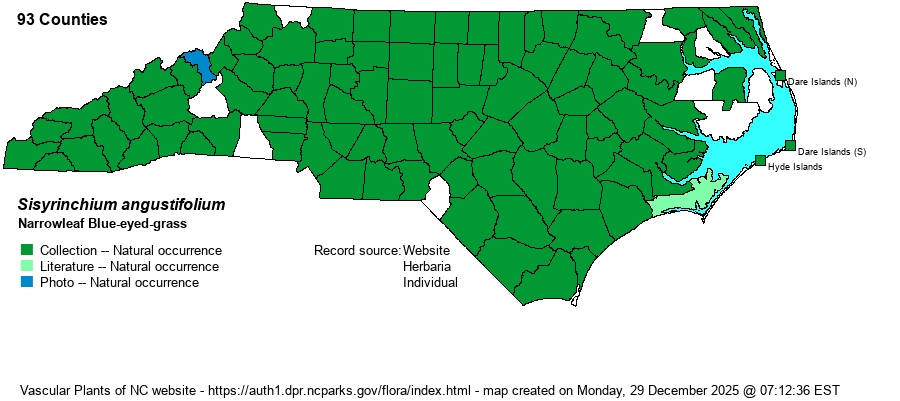| Author | P. Miller | |
| Distribution | Statewide, almost certainly found in all 100 counties, though still lacking records for a handful of random counties. This is our only blue-eyed-grass that has a statewide distribution.
This is an Eastern species with a broad range and presence in most counties within the range. It occurs from southeastern Canada south to the Gulf Coast and to central TX.
| |
| Abundance | Frequent to common essentially across the state. Probably least numerous along the immediate coast. | |
| Habitat | This species has a wide array of habitats, from moist meadows moist fields, bottomlands, margins of floodplain forests, florest clearings. In some areas, such as the Sandhills and Coastal Plain, it favors moist to wet areas like seepages, savannas, and meadows. Thus, it inhabits the wetter portion of the habitat scale vs. drier as in S. atlanticum. | |
| Phenology | Blooms from March to June, and fruits from June to August. | |
| Identification | The species has a strongly widened/winged flowering stem, that reaches about 10-12 inches high, with the stem about 1/4-inch wide. The basal leaves are roughly the same width and length as the stem. In this species, leaf bases do not persist as bristles. Stems and leaves are plain green (vs. pale or glaucescent green in S. atlanticum). The plant normally is branched in the upper half, with one or two flowers at the tips; the flowers are deep blue to light blue, and about 1/2-inch across. Also note the very long pedicels to the flowers, which often carry the flowers 3-4 inches above the stem. Most other Sisyrinchium species have much shorter flower stalks. This is the blue-eyed-grass that an observer is most likely to see first on a general walk in the state. Eastern Blue-eyed-grass (S. atlanticum) is very similar when in flower, except that its leaves and stems are narrower and paler green; its fruits are black or blackish (vs. brown). | |
| Taxonomic Comments | None
| |
| Other Common Name(s) | Stout Blue-eyed-grass. Note that the specific epithet translates to "narrow foliage" or "narrow leaf", though this species really does not have narrow leaves in comparison with other species in the genus. | |
| State Rank | S5 | |
| Global Rank | G5 | |
| State Status | | |
| US Status | | |
| USACE-agcp | FACW link |
| USACE-emp | FACW link |

